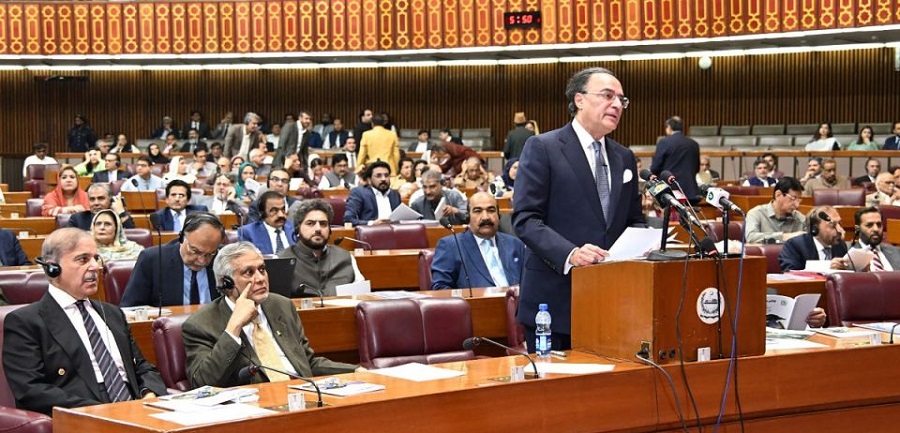
Kathmandu/In a landmark announcement Yesterday (11 June 2025), Finance Minister Senator Muhammad Aurangzeb unveiled Pakistan’s Budget for the fiscal year 2025/26, calling it a "performance-driven vision" for national prosperity.
Marking a sharp shift from past economic fragility, the budget reflects a confident turnaround-with inflation at a two-year low of 4.7%, a primary surplus of 2.4% of GDP, and a projected $1.5 billion current account surplus.
The government highlighted sweeping tax reforms, aiming to broaden the base without new levies. Nearly 400,000 non-filers have been identified, and Rs. 389 billion in enforcement revenue has been acknowledged by the IMF.
Salaried individuals and mid-sized corporates will see tax cuts, while sectoral incentives support agriculture, SMEs, IT, and green energy. A new carbon levy and Rs. 30 billion in Green Sukuk also point to climate-focused financing.
Provincial and federal development spending is pegged at Rs. 4.2 trillion, with strong allocations for health, education, and social protection. Public sector salaries are also set to rise by 10%.
The message is clear: the government is staying the course-shifting from crisis management to sovereign reform.
News Details:
Budget 2025–26: A Cohesive, Performance-Driven Vision for a Stronger Pakistan Minister of Finance & Revenue: Senator Muhammad Aurangzeb
- National Resolve and Economic Turnaround
Pakistan has made a decisive shift from economic fragility to financial stability and emerging confidence. The past year saw a remarkable transformation led by tough reforms, institutional credibility, and a resolute commitment to macroeconomic recovery. A primary surplus of 2.4% of GDP, the lowest inflation in over two years at 4.7%, and a projected current account surplus of $1.5 billion (from a $1.7 billion deficit) all point to a comprehensive turnaround—achieved without a single mini-budget or new tax imposition.
This performance is not coincidental but reflects policy clarity, prudent fiscal management, and trust in domestic institutions. Pakistan’s sovereign ratings were upgraded by Fitch, while Moody’s, IFC, ADB, and World Bank issued affirming outlooks. Remittances surged by 31%, reserves grew by $2 billion, and the KSE-100 hit record highs. PwC, OICCI, and Gallup all reported improvements in investor and public sentiment.
These results demonstrate that Pakistan’s macroeconomic stability is the product of local reform ownership. Economic direction has moved from dependency to discipline, from episodic reactions to strategic resilience. The foundation has been laid for a confident and sovereign financial future.
- Performance-led Compliance, Tax Enforcement and FBR Transformation
Budget 2025–26 marks a transformative departure from Pakistan’s historical pattern of overburdening the compliant while ignoring the undocumented. The reform vision pivots from taxing the taxed to expanding the net—with equity and technology as its anchors.
The FBR Transformation Plan, launched in September 2024, is based on People, Process, and Technology. It includes:
- AI-enabled audit systems
- Faceless customs processes
- Digital Production Tracking (sugar sector expanded to cement, beverages, textiles)
- E-Invoicing nationwide
- POS integration across provinces
- E-way billing
- Enforcement alerts and centralized monitoring
These measures are driving outcomes:
- 390,000 high-value non-filers detected
- Rs. 9.8 billion in fake refunds blocked
- Rs. 3 billion recovered through data-based enforcement
- Filer base doubled, tax-paying entities up 100%
For the first time, Rs. 389 billion revenue generated purely through legal enforcement was acknowledged by the IMF.
Pakistan’s complex income tax returns have been simplified from 800 fields to 7 for salaried individuals and small businesses. Procedural fairness is ensured with audit oversight committees and taxpayer rights to appeal. No mini-budgets, no surprise levies—just compliance-driven, transparent growth.
- Structural Reforms: Staying the Course
Structural reforms remain the centerpiece of Pakistan’s economic rebirth. Tariff rationalization, energy sector overhaul, debt reforms, and rightsizing of government reflect a clear departure from consumption-driven, import-heavy economics to sustainable, productive, export-oriented development.
Tariff Reforms:
- Elimination of Additional Customs Duties (ACDs) in 4 years and Regulatory Duties (RDs) in 5 years
- Reduction to 4 Customs Duty slabs (0%, 5%, 10%, 15%)
- Average tariffs to fall from above 20% to below 10%
These changes aim to:
- Make raw materials cheaper for local industries
- Remove anti-export bias
- Promote productivity, competition, and employment
The reforms are backed by an inter-ministerial implementation committee and a roadmap to address energy, finance, industrial, and forex bottlenecks.
Energy Sector:
- Industrial power tariffs cut by 31%, household relief over 50%
- Rs. 3 trillion saved through IPP renegotiations
- Decommissioned 3,000+ MW of inefficient plants
- DISCO losses reduced by Rs. 140 billion through governance
Debt & SOE Reforms:
- Rs. 1 trillion domestic debt bought back; Rs. 850 billion saved in interest
- SOEs categorized for PPP, privatization or restructuring
- NTDC split into three companies for efficiency
- 40,000 vacant posts abolished; 10 ministries restructured
Pension Reforms:
- Pensions indexed to CPI
- Elimination of multiple pensions
- Early retirements discouraged; 10-year limit on family pensions
- Budget 2025–26: Strategic, Responsive and Relieving
This budget is a turning point in fiscal policy—rebalancing rather than raising burdens. For the first time in decades, tax relief is being extended in recognition of performance—not pressure.
Tax Relief:
- Salaried class: 600k–1.2M bracket cut from 5% to 2.5%; 1.2M–2.2M reduced to 11% (from 15%); 2.2M–3.2M to 23% (from 25%)
- Super Tax reduced by 0.5% for mid-sized corporates
- Stamp duty cut in Islamabad from 4% to 1%
- WHT rates on property purchases reduced; FED abolished
Sectoral Incentives:
- Agriculture: Rs. 100,000 collateral-free digital loans for 750,000 farmers
- SMEs: Rs. 641 billion financing to 262,000 businesses; target Rs. 1.1 trillion by 2028
- Construction: New tax credit for low-cost housing (10 marla/2000 sq ft)
- IT: 21.2% export growth, target of $25 billion by FY2030
Green Economy:
- Carbon levy introduced
- Green Sukuk worth Rs. 30 billion issued
- EV incentives to reduce fossil-fuel reliance
Relief measures may be modest in amount but signal a directional shift in governance—from imposition to facilitation, from stagnation to empowerment.
- Whole-of-Government Approach to Inclusive Development
This budget reflects a unified national approach across federal and provincial tiers:
- Rs. 4.2 trillion development allocation: Rs. 1T Federal PSDP, Rs. 2.87T Provincial ADPs
- 60% of provincial budgets focused on health, education, water, and social protection
- BISP allocation increased to Rs. 716 billion, covering 10M families and 12M children
- 10% salary increase for public servants (grade 1-22); disparity allowance increased to 30%; 7% pension hike
- Rs. 201B for health and Rs. 144B for education development
This shared fiscal direction is embedded in the National Fiscal Pact and reflects whole-of-government ownership to uplift the vulnerable while enabling long-term productivity.
- Driving Future Prosperity: Strategic Sectors
Agriculture:
- Rs. 2.07 trillion agri-credit issued (16% growth)
- New National Seed Authority & digital seed certification launched
- E-wallet financing systems to reduce informal borrowing
IT:
- $3.1B exports in 10 months; $25B target for next 5 years
- Global recognitions in e-Government and cybersecurity
- 185,000 jobs created through startup ecosystem
Climate & Green Finance:
- $40B Country Partnership with WB/IFC, one-third climate-focused
- $1.4B Resilience & Sustainability Facility (IMF)
- $77M Recharge Pakistan for flood resilience
Mining:
- Reko Diq to generate $75B, create 41,500 jobs
- $7.8B in royalties and $7B in taxes expected
- Infrastructure to link mines to ports under construction
Conclusion: Confidence, Commitment and Continuity
Budget 2025–26 signals a break from the past. It replaces reaction with strategy, burden with relief, and stagnation with bold, equitable reform. The government has chosen to stay the course and own its path to long-term prosperity.
This is not merely a fiscal document—it is a statement of sovereign reform, resilience, and responsibility.
Stay the Course. Deliver the Prosperity.










1704854521.jpg)